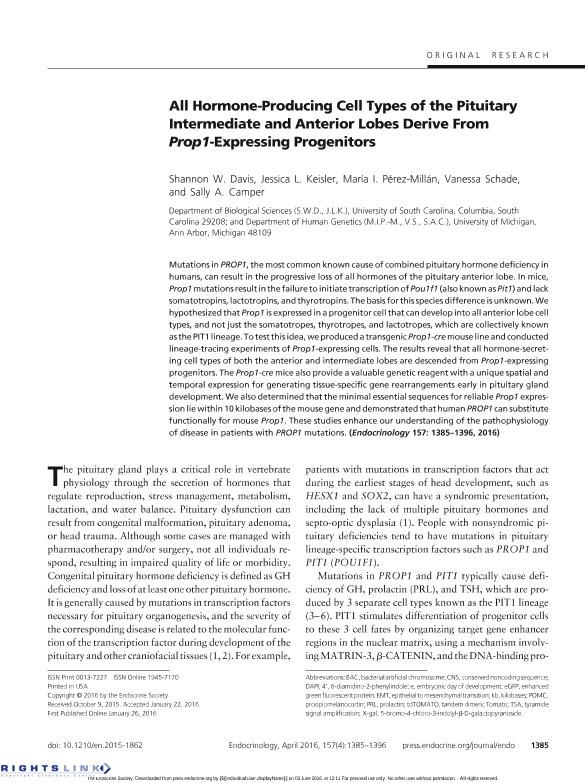Artículo
All hormone-producing cell types of the pituitary intermediate and anterior lobes derive from prop1-expressing progenitors
Davis, Shannon W.; Keisler, Jessica L.; Pérez Millán, María Inés ; Schade, Vanessa; Camper, Sally A.
; Schade, Vanessa; Camper, Sally A.
 ; Schade, Vanessa; Camper, Sally A.
; Schade, Vanessa; Camper, Sally A.
Fecha de publicación:
04/2016
Editorial:
Endocrine Society
Revista:
Endocrinology
ISSN:
0013-7227
Idioma:
Inglés
Tipo de recurso:
Artículo publicado
Clasificación temática:
Resumen
Mutations in PROP1, the most common known cause of combined pituitary hormone deficiency in humans, can result in the progressive loss of all hormones of the pituitary anterior lobe. In mice, Prop1 mutations result in the failure to initiate transcription of Pou1f1 (also known as Pit1) and lack somatotropins, lactotropins, and thyrotropins. The basis for this species difference is unknown. We hypothesized that Prop1 is expressed in a progenitor cell that can develop into all anterior lobe cell types, and not just the somatotropes, thyrotropes, and lactotropes, which are collectively known as the PIT1 lineage. To test this idea, we produced a transgenic Prop1-cre mouse line and conducted lineage-tracing experiments of Prop1-expressing cells. The results reveal that all hormone-secreting cell types of both the anterior and intermediate lobes are descended from Prop1-expressing progenitors. The Prop1-cre mice also provide a valuable genetic reagent with a unique spatial and temporal expression for generating tissue-specific gene rearrangements early in pituitary gland development. We also determined that the minimal essential sequences for reliable Prop1 expression lie within 10 kilobases of the mouse gene and demonstrated that human PROP1 can substitute functionally for mouse Prop1. These studies enhance our understanding of the pathophysiology of disease in patients with PROP1 mutations.
Palabras clave:
Prop1
,
Pituitary
,
Stem Cells
,
Cre
Archivos asociados
Licencia
Identificadores
Colecciones
Articulos(BIOMED)
Articulos de INSTITUTO DE INVESTIGACIONES BIOMEDICAS
Articulos de INSTITUTO DE INVESTIGACIONES BIOMEDICAS
Articulos(INBIOMED)
Articulos de INSTITUTO DE INVESTIGACIONES BIOMEDICAS
Articulos de INSTITUTO DE INVESTIGACIONES BIOMEDICAS
Citación
Davis, Shannon W.; Keisler, Jessica L.; Pérez Millán, María Inés; Schade, Vanessa; Camper, Sally A.; All hormone-producing cell types of the pituitary intermediate and anterior lobes derive from prop1-expressing progenitors; Endocrine Society; Endocrinology; 157; 4; 4-2016; 1385-1396
Compartir
Altmétricas



